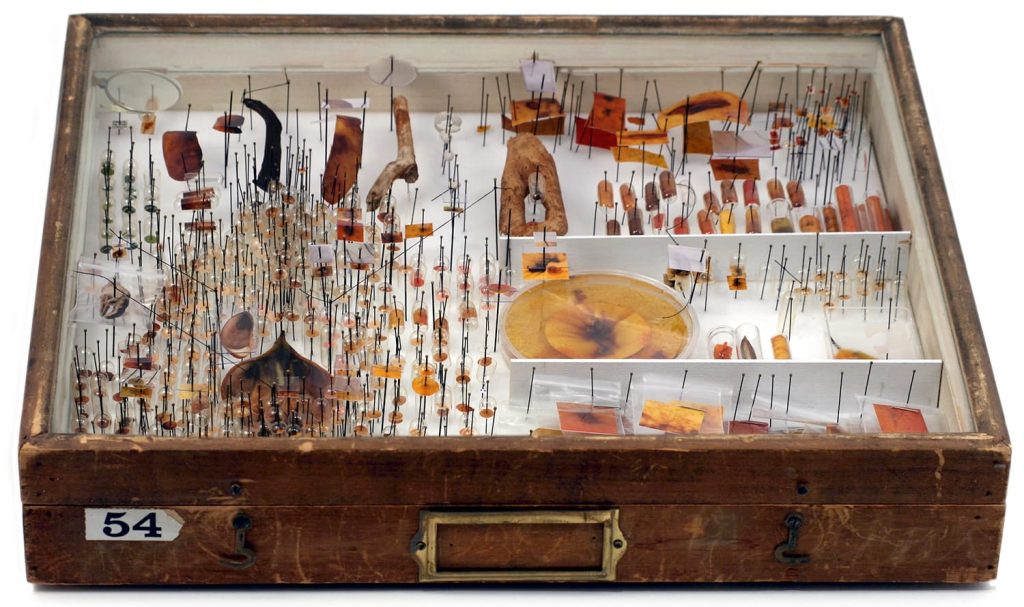We spoke with Michael Mapes, the contemporary American artist known for his unique mixed-media portraits and assemblages. He creates intricate collages and compositions using a variety of materials, including dissected photographs, pins, insect specimens, and other found objects.
Michael Mapes’ work has been exhibited internationally and has gained recognition for its innovative approach to portraiture and its thought-provoking exploration of the human form.
TWS –Can you tell us something you’d like our readers to learn about you?
MM –My commercial work doesn’t come up much but it spanned nearly 20 years. In the late 80’s, I started a company called MINC, a wholesale product company. Most of the products were t-shirts. In the early going, the ideas were whatever interested me. The small company had a great spirit and several very successful products, the biggest seller being a whimsical field guide to bird droppings. MINC sold to retail stores and catalogue companies in the US and abroad. It was a great fit for me. I utilized my creative sense alongside my design skills. Over time, the market for t-shirts began to change and so did the business and my enthusiasm to have it. So, after a good run, I stopped. I wanted to do something self directed. Following a couple of years of exploring video production, I began pondering a serious commitment to the studio.
TWS –In your website’s profile picture, we see a young Michael with a collection of dissected butterflies. What attracted you most when you were a child: entomology or art? And how did that change over the course of the years?
MM –When I shared that photo a few years ago, I actually had to be reminded that I made insect collections. Being an entomologist was never on my short list. I can’t imagine that I knew it was even a thing. I drew and painted all the time. Dinosaurs, birds, pets and people. I was interested in just making the art more than in any particular subject. I struggled for years with what to draw or what to paint. I mostly did portraits. Very academic portraits.
In grad school, I had several friends from various branches of science – chemistry, physics, anthropology. I was lucky to meet intelligent people that were creative minded in their fields. They loved talking outside of a straight science way. That had a big influence on my grad student thinking and later, the pseudo-scientific metaphor in so much of my work.

2023
40″ x 50″

2023
40″ x 50″
TWS –Your work has been divided between art and design. How do you balance both sides? Can you elaborate on the connections and differences between them?
MM –My experience in the 1980’s, certainly in college, was that you chose between commercial and fine art. I decided to study graphic design, despite wanting to be an artist. In truth, I really just wanted to leave my home town and have a different experience. My folks pointed out the challenges art likely posed to making a living. They were not incorrect. I can’t say I identified as an artist early on. I thought of myself as a creative, owing in part, I’m sure, to punishing insecurity. A degree in design turned out to be a great decision for me. Art school would have been a disaster. Years later, when I circled back to art, I still perceived differences. To me, art has an intention that is self directed. I am the client. I determine what is communicated and how to do so. As for the question of balance, I utilize my design skills, in large part, like I would hire someone to design a website, a catalog or produce social media. That said, there’s no question my background in design finds its way into the compositions.
TWS –I’m always intrigued by an artist’s journey of discovering their unique voice and artistic approach. Could you guide us through the path that led you to find your artistic style and the elements that make your work so unique and distinct?
MM –I was 40 when I decided to pursue art full time. That late start afforded me greater patience and creative maturity. I did a lot of work to overcome insecurity. I also developed business skills, which take the pressure off the creative end. The challenge was rethinking my creative process. Suddenly, there was no obstacle to creating whatever I wanted. Or excuse. In the first year, I collided with being derivative. I would spend a good long day only to see a bad Cy Twombly. Part of the problem was medium. I could paint, draw, take pretty good photos, but wasn’t great (or committed) to any one medium. A lot of the early work was drawing. I was essentially channeling the process of writing into a drawing mode. It was by chance that I happened upon the metaphor that is still pervasive to my work. I had a photo of a friend I had taken at a Paris cafe and a bag of sewing pins my mom had given me years prior. I hole punched the print and pinned the pieces back to the original photo. That was my genesis moment. I had an intuitive sense of how to take that idea in different meaningful directions. Once I created the first finished work, I viewed it as my approach. That was important to me.
TWS –I read that you have always leaned toward a pseudo-scientific aesthetic. Can you expand on this idea? How does the scientific world help you tell your stories?
MM –I’ve always liked the look of science. Knowing the look was easier than knowing the science. The aesthetic of science, which I take creative licenses with, became the metaphor in much of my work. Most of my art, in various ways and degrees, is seen through the lens of this scientific metaphor – Gestalt psychology, entomology, forensic science, biology. The pseudo-science compositional approach is an effective entry point for inspiring further consideration of the work. The fact it’s so detailed encourages examination and thought – a kind of reverse engineering of my reverse engineering. That can be important in making the work but also in inspiring people to spend time with it.

2018
28″ x 34″

2018
28″ x 34″
TWS –The level of detail in your artworks makes me think that obsession is a keyword to understanding your art. Is obsession something that you feel connected to?
MM –I feel connected though I don’t regard it as key to understanding the actual art. It has more significance with appreciating the process of making it. Creating very detailed artwork demands time and persistence. From the beginning, I liked the idea of making art that requires a high level of craft, in part, because I wanted to spend the time in the studio making it. As a holdover from my previous work, I wanted my art to be made by me, wherever possible. Given this approach, I was inspired (or forced) to dispense of hastiness and developed a patience. That patience was necessary as the work is so labor intensive. Eventually, I connected to my obsessive tendencies and channeled them as means to stay focused and productive for longer hours.
TWS –Another aspect that comes to mind when seeing your artworks is “precision.” I was wondering how much planning and space for improvisation there is when creating your pieces?
MM –Another great question. The latitude for improvisation in the work is somewhat dependent on the subject. In most of my art, there’s great capacity for improvisation. Commissioned portraits tend to be more straightforward, for whatever reasons, which is also to say, there’s more planning. But overally, the compositions aren’t planned. I approach work like a painter – or should I say, like the painter I used to be when I did portraits. I like to work at a quicker pace when composing the actual piece. A faster approach translates to a fluid one. That requires, when possible, to have hundreds of individual elements already on hand prior. A majority of the time is spent creating and sourcing individual content. That’s a grind. Once I begin the composition, I balance using pre-existing material with making new content in the flow of the work. It’s hard to know what I want and what I’ll use until I’m actually working on it. I often abandon considerable unused elements in a completed work. Over the years, as you would expect, I’ve developed a have a much better sense of how to make my work. With that, comes a more intuitive sense of decision making.

2007
16″ x 14″

2007
16″ x 14″
TWS –Could you share some insights into the ideas that underlie your work?
MM –I wanted to express the subject beyond the surface. Understanding the relevance to Gestalt principles was important to my work. As my first series, “Human Specimens” was portraiture, these principles gave weight to content and compositional considerations. I coined the term “biographical DNA” to describe individual elements in the work. I balanced the compositions such that works can be meaningfully experienced up close and at a distance – a collection of details. I continue to find ways to push content, composition and metaphor to visually represent subjects in ways that invite, though don’t necessarily require, an attention to detail.
TWS –Do you feel your work is connected to the tradition of collage? Was collage something that you felt a connection to?
MM –Before making this work, I had never made a collage. In fact, I wasn’t sure what to say when people asked what kind of art I made. Early on, I thought of it as somewhere between collage and assemblage. I came to recognize that it wasn’t a neat fit, nor did it need to be. Now, I identify as a collage artist and often describe the work as dimensional collage.
Learn more about Michael Mapes on his website or Instagram

2016
23″ x 28″

2016
24″ x 28″

2016
24″ x 28″

2013
28: x 34″

2013
28: x 34″

2007
19″ x 25″

2008
14″ x 16″

2008
14″ x 16″





